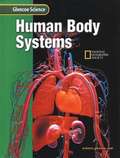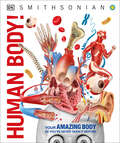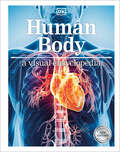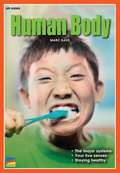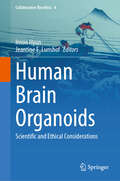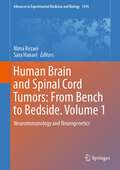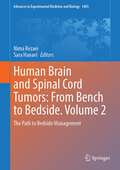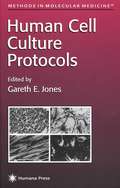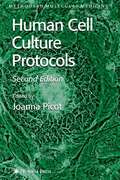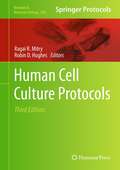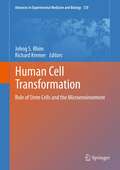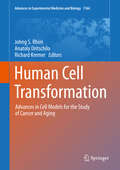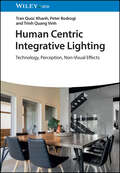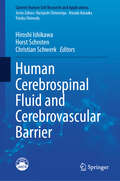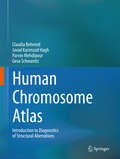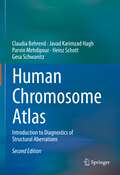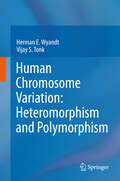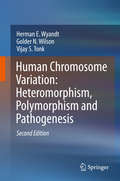- Table View
- List View
Human Body Systems: Course D
by McGraw-Hill Glencoe"Science meets students where they are through engaging features and thought-provoking questions that encourage them to relate the science concepts to the world around them.
Human Body! (DK Knowledge Encyclopedias)
by DKExplore the human body as you&’ve never known before with this ultimate kid&’s guide to what goes on under our skin. Forming part of a fantastic series of kid's educational books, this bold and brilliant kid's encyclopedia uses ground-breaking CGI imagery to reveal the human body as you've never seen it before. Informative, diverse in subject matter, easy-to-read and brimming with beautiful graphics, young learners can explore the incredibly detailed cross-sections and cutaways that reveal the inner workings of these fascinating and complex machines we know as our bodies!This charming children&’s encyclopedia opens the world in new ways, with: - Packed with facts, charts, infographics and illustrations that cover the human body head to toe- Encompassing a visual approach with illustrations, photographs and extremely detailed 3D CGI images- Crystal clear text distills the key information.- DK's encyclopedias are fact-checked by subject experts to offer accuracy beyond online sources of information.This fully-updated edition of Knowledge Encyclopedia Human Body! is the perfect encyclopedia for children aged 9-12, ideal for inquisitive minds, with a unique head-to-toe approach that makes the complex structure of the human body both appealing and accessible for curious young readers. Jam-packed with fun facts about the human body, including creative CGI artworks that can be rotated and animated to bring the aspects of this body book to life! Curious children can take a look at the life of a cell, discover the digestive system, and learn all about record-breaking bodies!Explore, Discover And Learn!DK's Knowledge Encyclopedia Human Body! uncovers the marvels of our body in unprecedented detail and with stunning realism. Encompassing engaging facts about the human body, including a closer look at each bodily system, such as the nervous system, muscle system and more, and exploring a timeline of medical milestones, you can spend quality time exploring the wonders of the human body with children, accompanied by impressive visuals to engage their senses. A must-have volume for curious kids with a thirst for knowledge, this enthralling encyclopedia is structured in such a way that your child can read a bit at a time, and feel comfortable to pause and ask questions. Doubling up as the perfect gift for young readers, who are always asking questions about our planet! At DK, we believe in the power of discovery. This thrilling kid&’s encyclopedia is part of the Knowledge Encyclopedia educational series. Celebrate your child&’s curiosity as they complete the collection and discover diverse facts about the world around them. Dive into the deep blue with Knowledge Encyclopedia Ocean! Travel back in time to when dinosaurs roamed the earth with Knowledge Encyclopedia Dinosaur! And hone your knowledge on how the human body works with Knowledge Encyclopedia Human Body! Whatever topic takes their fancy, there&’s an encyclopedia for everyone!
Human Body: A Visual Encyclopedia (DK Children's Visual Encyclopedias)
by DKLook inside yourself for the first time with the ultimate body book for children. From the hair on your head to the tips of your toes, this essential encyclopedia explores the super science going on under your skin.Did you know your amazing body consists of 100 trillion cells? Or that your blood vessels laid out end to end would wrap around planet Earth twice? And that you&’ll munch through 20 tonnes of food in your lifetime? Find out all this and much more on the epic journey of self-discovery, not forgetting your heads, shoulders, knees, and toes! During this introduction to anatomy, you&’ll stop off to see the different organs and systems designed to keep us going all day long. Check out the brilliant brain in action at the body&’s control center, the heart that never stops beating, the huge lungs filling with air to breathe, and the strong skeleton that keeps you from turning to jelly. Peel back the layers as you go deeper into the muscles, bones, cells, and finally, the DNA that makes you different from everyone else. This international best-seller has been fully updated to include the latest research on the human body. Stunning photographs, CGI artworks, and eye-catching graphics work together with accessible text, fun-filled facts, and quirky quizzes to ensure an exciting and educational experience that is second to none. This brilliant body book is the perfect study aid or homework help – and you&’ll never see yourself in the same way again!Supports the Common Core State Standards.
Human Body: FOSS Science Stories
by University of California at Berkeley Lawrence Hall of ScienceNIMAC-sourced textbook
Human Brain Organoids: Scientific and Ethical Considerations (Collaborative Bioethics #4)
by Insoo Hyun Jeantine E. LunshofBrain organoids are small stem cell-derived, self-organizing models of specific brain regions that offer researchers new ways to study the human brain. Since their scientific debut over ten years ago, brain organoids have been used to generate tractable new bioengineered tools for understanding functional interconnectivity of the human brain, dysfunction involved in many neurodegenerative diseases, and certain molecular mechanisms underlying cognition. Despite this field’s considerable scientific promise, advances in human brain organoid research also raise novel philosophical questions and ethical concerns around the use of complex human brain models and the ethical boundaries that should exist when manipulating increasingly realistic bioengineered brain constructs. As researchers generate more realistic organoids in vitro that resemble human brains, it is critically important to understand what ethical boundaries may exist and where researchers and regulators should draw the line for research, both to reduce uncertainties over which projects to pursue in the lab and to address future concerns regulators and the public may harbor about whether this research, if left unexamined, could inadvertently undermine public trust in science. This proposed book delves into ongoing and proactive ethical discussions among ethicists and the neuroscientists involved with this cutting-edge work. Its ultimate goal is to foster greater awareness, understanding, and guidance for future management of ethical issues that may be unique to new areas of brain organoid research. This volume is the result of a close partnership between ethicists and scientists, each informing the other through a collaborative process of joint bioethical deliberation.
Human Brain and Senses Resources: Images, Data, and Readings
by Lawrence Hall of Science StaffTHE FOSS program for Middle School Science
Human Brain and Spinal Cord Tumors: Neuroimmunology and Neurogenetics (Advances in Experimental Medicine and Biology #1394)
by Nima Rezaei Sara HanaeiBrain tumors comprise about 5–9% of all human neoplasms; and interestingly the central nervous system (CNS) neoplasms are ranked among the most prevalent neoplasms of childhood as well. Besides to the morphologic and histopathologic characteristics, and as each pathologic states first starts with molecular alterations, each tumor may have its own story in the matter of activating tumorigenesis pathways and having specific molecular characteristics. Importantly, the molecular classification of tumors has been highly considered in the past few decades for taking the most appropriate therapeutic approach. On the other hand, the tumors shall have tumor-scape mechanisms preventing the immunologic system to eliminate its invasion. The failure of innate and acquired immune system to defeat tumorigenesis mechanisms would consequently result in tumor development. Interestingly, the neuro-immunologic mechanism plays a role in development of psychiatric manifestations of brain tumors as well. Taking all these to account, the different arms of innate immunity, acquired immunity, and genetics have been approached to defeat development and/or progression of such tumors. Accordingly, the activation immunotherapeutic approaches focus on activating or strengthening the anti-tumor immunologic pathways in order to assist the weakened immune system to defeat the tumor (such as Dendritic cell vaccination, DNA vaccines, peptide vaccines, viral vector-based vaccines, monoclonal antibodies, and CAR T-cell therapy). In addition to immunologic components of brain and spinal cord tumors, numerous genes and genetic pathways have been recognized to take part in tumorigenesis. Taking these non-immune genetic pathways to account, some other therapeutic approaches such as stem cell therapy and gene therapy have been developed in the new era of cancer treatment. Moreover, and besides the biologic and medical aspects of these tumors, different physical/mathematical models have been proposed to either explain or predict tumor behavior. Such models would be advantageous in developing new therapeutic modalities in pre-clinical stages and enter new eras in cancer treatment. The first book of Human Brain and Spinal Cord Tumors, Neuro-immunology and Neuro-genetics, will mainly discuss the neuro-immunology and neurogenetic pathways associated with development of brain and spinal cord tumor. After a short introduction chapter, this book will focus on the role of innate and acquired immunity on development of these tumors and then the immunotherapeutic approaches to defeat these tumorigenesis mechanisms. This book will then focus on genetic aspects of brain and spinal cord tumors and bioinformatics models to describe the behavioral patterns of these tumors, as well as associated therapeutic approaches such as stem cell therapy and gene therapy. This volume of book could be useful for experts in basic sciences, mainly geneticists and immunologists, and also physicians of different specialties, mainly neurosurgeons, neurologists, neuropathologists and neuroradiologists.
Human Brain and Spinal Cord Tumors: The Path to Bedside Management (Advances in Experimental Medicine and Biology #1405)
by Nima Rezaei Sara HanaeiThis book aims to gather the current knowledge regarding different aspects of brain and spinal cord tumors in order to more efficiently help the patients. Brain tumors comprise about 5–9% of all human neoplasms; and the central nervous system (CNS) neoplasms are ranked among the most prevalent neoplasms of childhood as well. The more we know about the nature and characteristic of brain and spinal cord tumors, the more precise decision could be made for each patient, in order to reach the best outcome. While surgical resection, chemotherapy, and radiotherapy have been considered as the standards of care for benign and/or malignant CNS tumors since a long time ago, new therapeutic approaches such as immunotherapy have been recently proposed to be considered for treatment of CNS tumors, especially as in some cases, the tumors might be inoperable or the patient may not benefit from other treatment modalities after several recurrences. The second volume of the book focuses on clinical aspects of these tumors. Accordingly, the most important brain and spinal cord tumors are specifically discussed in each chapter based on a rational outlining for all chapter in this volume: Background and epidemiology, genetics, immunology and molecular biology, histopathology and morphology, imaging and radiologic features, clinical manifestations, therapeutic approaches, surgical intervention, chemotherapy and radiotherapy, new therapeutic modalities, follow-up, and prognosis. The chapters of this volume discuss the following pathologies of brain and spinal cord tumors: malignant glioma, benign glioma, meningiomas and other meningeal tumors, ependymomas, medulloblastomas, pineal tumors, choroid plexus and ventricular tumors, neuroectodermal tumors of CNS, neuroepithelial tumors of CNS, pituitary gland tumors, craniopharyngioma, schwannomas and nerve-sheet tumors, hemangioblastomas and other vascular originating tumors, brain and spinal tumors of embryonic origin, germ line cell tumors, malignant bone or cartilage-originating tumors of brain and spine, benign bone or cartilage-originating tumors of brain and spine, brain tumors affecting the orbit globe and orbit tumors affecting the brain, CNS lymphomas, metastatic lesions of the brain and spine, malignant spinal tumors, benign spinal tumors, brain and/or spinal cord tumors accompanied with other diseases or syndromes, psychological and psychiatric aspects of brain and spinal cord tumors, a brief explanation on surgical approaches for treatment of different brain tumors. This volume of book is useful for physicians of different specialties, mainly neurosurgeons, neurologists, neuropathologists, and neuroradiologists.
Human Cell Culture Protocols
by Gareth E. JonesExpert scientific and clinical investigators present proven human cell culture techniques applicable to tissue samples taken from a wide variety of organs, particularly those prone to pathological change. They describe in clear, step-by-step instructions the special requirements for successfully culturing such human cells as T-cells, trophoblast cells, renal cells, natural killer cells, endothelial cells, neurons, epithelial cells, pituitary cells, and more. The protocols eliminate much of the chore of adapting techniques initially developed for animal cell culture systems or the time spent in hunting down potentially useful techniques buried in the details of research papers, or even in books largely devoted to animal cell culture. They allow researchers to use successfully high quality in vitro cultures as models to explore the disease process.
Human Cell Culture Protocols
by Joanna PicotA thoroughly revised and updated collection readily reproducible techniques for culturing human cells. This new edition includes a wide range of human cell types relevant to human disease and new chapters on fibroblasts, Schwann cells, gastric and colonic epithelial cells, and parathyroid cells. The protocols follow the successful Methods in Molecular MedicineTM series format, each offering step-by-step laboratory instructions, an introduction outlining the principle behind the technique, lists of the necessary equipment and reagents, and tips on troubleshooting and avoiding known pitfalls.
Human Cell Culture Protocols
by Ragai R. Mitry Robin D. HughesHuman cell culture is not a new topic, but the development of new molecular techniques and reagents which can be used to investigate cell function and the responsible intracellular mechanisms make it a continuing requirement. This third edition of Human Cell Culture Protocols expands upon the previous editions with current, detailed protocols for the isolation and culture of a range of primary cells from human tissues. With new chapters on pancreatic cells needed for basic studies on the pathogenesis of diabetes and for their application for islet transplantation, the book also delves into protocols for hepatocytes, skin cells, lung cells, parathyroid cells, gastric cells, renal cells, adipocytes, ovarian cells, bone cells, vascular smooth muscle cells, vascular endothelial cells, regulatory T cells, blood mononuclear cells, as well as new techniques being applied to human cell culture, particularly the use of biocompatible scaffolds to grow cells, the in vitro use of laser microdissection to isolate cells from culture, and automated cell culture. Written in the highly successful Methods in Molecular BiologyTM series format, chapters include introductions to their respective topics, lists of the necessary materials and reagents, step-by-step, readily reproducible laboratory protocols, and tips on troubleshooting and avoiding known pitfalls. Authoritative and cutting-edge, Human Cell Culture Protocols, Third Edition makes it possible for a worker with basic cell culture training, whether in the fields of cell biology, gene therapy, and cell transplantation, to prepare cell cultures of the specific cell type necessary to forward their vital research.
Human Cell Transformation
by Richard Kremer Johng S. RhimRhim and Kremer's state-of-the-art volume on Human Cell Transformation: Role of Stem Cells and the Microenvironment highlights the latest findings on the current state of human cell transformation model systems and provides the insight into the molecular and cellular changes involved in the conversion of normal cells to neoplastic cells. Chapters cover all recently developed novel human cell models. In addition, the rapidly growing fields of knowledge regarding not only stem cells in cancer progression, but also the role of the microenvironments in human carcinogenesis are discussed. A wealth of topics is presented including: · Derivation of epithelial, fibroblastic, and hematopoietic in vitro model systems · Oncogenes · Tumor suppressor genes · Viral transformation · In vitro model systems for viral, chemical and radiation carcinogenesis · Cell aging · The multistep nature of human carcinogenesis · The role of stem cells and the microenvironment in tumorigenesis · The genes involved in multistep carcinogenesis Unique in both scope and focus - devoted solely to human cell transformation systems - Human Cell Transformation: Role of Stem Cells and the Microenvironment provides unparalleled, in-depth coverage for cancer researchers, cell and molecular biologists, hematologists, virologists, and workers in related fields. Essential reading for everyone who needs to be kept up-to-date in this fast-paced area! Features Ø Multistep models Ø Breast cancer/Stem cells Ø Prostate cancer/Stem cells Ø Multistep / Genes
Human Cell Transformation: Advances in Cell Models for the Study of Cancer and Aging (Advances in Experimental Medicine and Biology #1164)
by Richard Kremer Johng S. Rhim Anatoly DritschiloThis book, part contributed volume, part proceedings, discusses state-of-the-art advances on human cell transformation in cell models for the study of cancer and aging. Several of the chapters are from the Human Cell Transformation: Advances in Cell Models for the Study of Cancer and Aging conference that was held in June 2018 at McGill University. The authors represent international expertise on a wide variety of topics ranging from different types of cancer (prostate, bone, breast, etc.) to tumor microenvironment, tumor progression, homogeneity, and possible therapies and treatments.
Human Centric Integrative Lighting: Technology, Perception, Non-Visual Effects
by Tran Quoc Khanh Peter Bodrogi Trinh Quang VinhHuman Centric Integrative Lighting Detailed presentation of the technical and non-technical aspects of modern lighting and its effect on humans Human Centric Integrative Lighting provides a highly comprehensive overview of the subject, also referred to as human-centered indoor lighting technology; taking a practice-oriented approach, scientific findings in the field are condensed into models that can be directly used by developers. Written by leading scientists in the field of lighting technology, Human Centric Integrative Lighting includes detailed information on: Fundamentals of lighting technology as it interacts with human perception and the current state of interior lighting today Basic principles of human centric integrative lighting and its various aspects, such as visual performance, color quality, emotional impact, and correlation of relevant parameters Comprehensive lighting quality models and subsequently derived recommendations for the practical implementation of concepts Relevant research findings from journals, patent specifications, and standards to provide a unified outlook on the field Providing a comprehensive overview of the current state of development in the field, Human Centric Integrative Lighting discusses validated physiological and psychological perceptual models on which manufacturers of lighting products and suppliers of lighting technology solutions can base key design and development decisions. lighting products; lighting technology solutions; lighting design; lighting development; human-centered indoor lighting technology; lighting color quality; lighting principles; lighting emotional impact; lighting quality; lighting research
Human Cerebrospinal Fluid and Cerebrovascular Barrier (Current Human Cell Research and Applications)
by Hiroshi Ishikawa Horst Schroten Christian SchwerkThis book offers a basic understanding of the complex mechanisms that protect the brain from harmful substances while still allowing for essential functions such as nutrient transport and waste removal. It explores the blood-cerebrospinal fluid barrier (BCSFB) and the blood-brain barrier (BBB) in depth, focusing on the latest research, innovative techniques, and unique perspectives from researchers worldwide. The book also examines the clinical relevance of brain barrier dysfunction, with a particular focus on multiple sclerosis (MS) and the potential role of brain barriers in the development of MS, intricate relationship between brain barriers and infectious diseases and much more. With contributions from experts in neurobiology, microbiology, and biophysics, this book provides a multidisciplinary perspective. Extensive research has been conducted on the cerebrovascular or cerebrospinal fluid barrier function. The recent development of a functional epithelial cell line derived from a human choroid plexus papilloma has paved the way for an in vitro model of the choroid plexus, which has been instrumental in elucidating the interplay between infection, metabolism, physiological functions, and disease. This book is an effort by the Editors to raise public knowledge of the cerebrovascular and cerebrospinal fluid barriers. With broad coverage of topics in "Human Cerebrospinal Fluid and Cerebrovascular Barrier", it is ideal for researchers studying cerebrovascular or cerebrospinal fluid barrier interested in staying up to date on the latest developments. Healthcare providers and researchers working to develop new treatments for MS, infectious diseases of the central nervous system and other neurological disorders will also value this book. The book provides students of medicine, pharmacy, biology, and engineering with a comprehensive understanding of the structure and function of brain barriers. Those seeking a thorough introduction to the field will also find the book enjoyable.
Human Chromosome Atlas
by Parvin Mehdipour Claudia Behrend Javad Karimzad Hagh Gesa SchwanitzThis atlas presents the results of cases of structural chromosome aberrations based on the currently available methods of analysis for different types of abnormality. It particularly focuses on which spectrum should be chosen when combining the different techniques to achieve the best method of diagnosis in individual cases, for example direct preparation of cells and mitoses, short or long-time cell culture, fluorescence in situ hybridization (FISH), analysis of interphases, microarray or DNA sequencing. Generally it has to be taken into account, that the development of new and improved investigation methods is forthcoming. Thus, by improvement of diagnostic possibilities new fields of investigation arise, and special groups of patients with cytogenetic analyses can be re-analysed under new research questions.
Human Chromosome Atlas: Introduction to Diagnostics of Structural Aberrations
by Parvin Mehdipour Claudia Behrend Gesa Schwanitz Javad Karimzad Hagh Heinz SchottNow in its second edition, this atlas serves as an easy-to-use diagnostic guide for the analysis of the human karyotype. Split in four parts, it starts with a comprehensive introduction covering the molecular cytogenetic basics, the role of ethic committees and international quality control in the field of diagnostics. The main parts II and III show the spectrum of different types of chromosomal abnormalities by a combination of karyogram and ideogram. They compare the significance of different banding techniques, give the karyotype formula and describe morphological peculiarities of each case presented. The final part provides a detailed description of non-coding DNA variants and focuses on potential problems in the detection of aberrations. It also mentions necessary additional investigations and peculiarities to be considered when counselling carriers of a chromosomal aberration or their relatives. Given its comprehensive scope and practical approach, this atlas is an indispensable resource for researchers, clinicians and practitioners working in the field of cytogenetics and clinical genetics.
Human Chromosome Variation: Heteromorphism and Polymorphism
by Herman E. Wyandt Vijay S. TonkHuman Chromosome Variation: Heteromorphism and Polymorphism was formerly printed under the title "Atlas of Human Chromosome Heteromorphism". The Atlas has become a standard reference book in most cytogenetic laboratories and is cited as a significant reference in ISCN 2009. This revised version has updated and retained the most useful pictorial sections of the first edition, including the comprehensive review of normal and "not-so-normal" variations of the human karyotype with summaries and extensive reference lists organized by chromosome number. This updated edition features concise background information on chromosome methods and applications, essential information on heteromorphism frequencies in normal and clinical populations as well as new listing and discussions of euchromatic, subtelomeric and FISH variants. The addition of two new sections make this an even more valuable reference than before. A section on common and rare fragile sites includes a short historical discussion, definitions and an extensive table of officially recognized sites that includes the HUGO name, chromosomal location, methods of induction, genes and references to the most recent molecular characterization. A new section on array CGH discusses the clinical challenge of interpreting copy number variations (CNVs) revealed by this newest technology, gives examples of various levels of interpretation and lists the several most common websites used in this interpretation.
Human Chromosome Variation: Heteromorphism, Polymorphism and Pathogenesis
by Herman E. Wyandt Vijay S. Tonk Golder N. WilsonThis new edition now titled "Human Chromosome Variation: Heteromorphism, Polymorphism and Pathogenesis" provides the reader with an up-to-date overview of microarrays, fragile sites, copy number variations and whole genome sequencing. Greatly expanding the discussion of microarray analysis in the previous edition of the book, are new chapters on microarray and genomic analysis, plus comprehensive tables on the subtle microdeletions and microduplications that are found on each chromosome, including 235 recurring copy number variants that are associated with well-established or emerging chromosomal syndromes. The current edition features concise information on cytogenetic methods and applications, extending these discussions to DNA analysis and genome sequencing. Sections on euchromatin, heterochromatin, FISH pattern, fragile site, copy number, and DNA sequence variation are integrated with actual clinical examples from cytogenetic laboratories and from clinical practice. The principles that allow for the distinction between benign chromosome / DNA variation and pathogenic heteromorphisms / polymorphisms are discussed and include references to the latest organizational guidelines and genomic or population databases. The two previous incarnations of this book: the 'Atlas of Human Chromosome Heteromorphism', and 'Human Chromosome Variation: Heteromorphism and Polymorphism' have been standard reference works in most cytogenetic laboratories, used by laboratory directors and clinicians all around the world. While widely used sections from the previous edition on cytogenetic technologies and heteromorphisms are retained intact the present volume adds extensive material on copy number variations (polymorphisms detected by microarray analysis), fragile sites in disease and cancer, and practical views on interpreting emerging technologies, including whole exome sequencing. This book should be of interest to clinicians, technicians and students who are or will be exposed to DNA and/or chromosome analysis and the data derived from these continuously developing techniques. This fully updated book volume will bring the reader up to speed on the latest technologies, their applications, benefits and drawbacks and as such, is a must read for anyone with an interest in DNA and chromosome analysis and the distinction between benign variation and pathogenic mistakes.
Human Cloning
by Kerry Lynn MacintoshMany people think human reproductive cloning should be a crime-some states have even outlawed it and Congress is working to enact a national ban. However, if reproductive cloning soon becomes a reality, it will be impossible to prevent infertile couples and others from choosing the technology, even if they have to break the law. While most books on cloning cover the advantages and disadvantages of cloning technology, Illegal Beings describes the pros and cons of laws against human reproductive cloning. Kerry Lynn Macintosh, an attorney with expertise in the area of law and technology, argues that the most common objections to cloning are false or exaggerated, inspiring laws that stigmatize human clones as subhuman and unworthy of existence. She applies the same reasoning that was used to invalidate racial segregation to show how anti-cloning laws, by reinforcing negative stereotypes, deprive human clones of their equal protection rights under the law. Her book creates a new topic within constitutional law: existential segregation, or the practice of discriminating by preventing the existence of a disfavored group or class. This comprehensive and novel work looks at how anti-cloning laws will hurt human clones in a fresh perspective on this controversial subject. Kerry Lynn Macintosh is a member of the Law and Technology faculty at Santa Clara University School of Law. She is the author of papers, articles, and book chapters on the law and technology and has contributed to the Harvard Journal of Law and Technology, Boston University Journal of Science and Technology Law, and Berkeley Technology Law Journal.
